Speaker
Description
Photonic crystals are well known for their fascinating angle-dependent opalescence. In contrast to hard sphere building blocks, crystals from soft spheres such as microgels allow for external actuation, e.g. melting and recrystallization induced by pH or temperature changes.[1] In addition, soft spheres can be deformed and thus packing fractions well above the hard sphere limit are accessible. A drawback with respect to the optical diffraction of soft photonic crystals is the typically low refractive index modulation inside the material. This asks for pathways to increase the refractive index contrast in the periodic superstructure.
We prepared cm-sized soft photonic crystals from core/shell microgels with absorbing nanocrystal cores (gold nanoparticles) and systematically studied the crystal structure and diffractive properties.[2] As non-absorbing references, we prepared pitted particles from the same microgel batches by dissolution of the nanocrystal cores. The resulting purely organic microgels allowed for a direct comparison of structural and optical properties. Dynamic and static light scattering as well as small angle neutron scattering (SANS) were used to study the core/shell and pitted particles in the dilute state on different length scales. The crystal structure of samples at high volume fractions was analysed by SANS. Independent on the presence or absence of the gold cores, we found fcc crystal structures with pronounced Bragg peaks of several orders. We identify the role of small absorbing nanocrystal cores in soft photonic crystals and show options to alter the photonic behavior of such crystals in future studies.
References:
[1] M. Karg, T. Hellweg, P. Mulvaney, Adv. Funct. Mater. 21 (2011), 468.
[2] A. Rauh, N. Carl, R. Schweins, M. Karg, Langmuir 34 (2018), 854.

